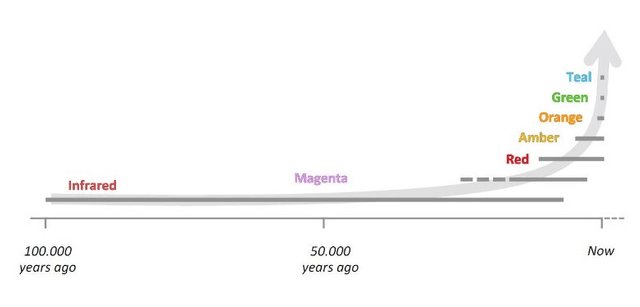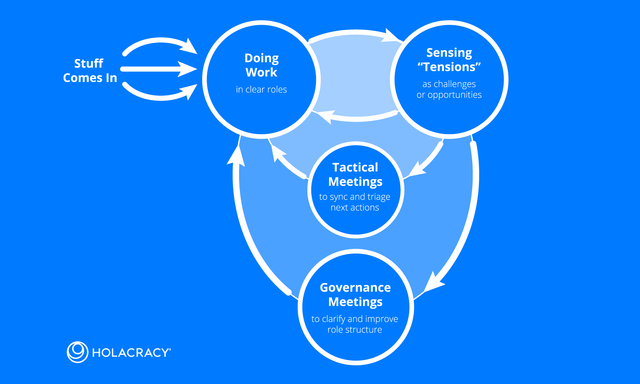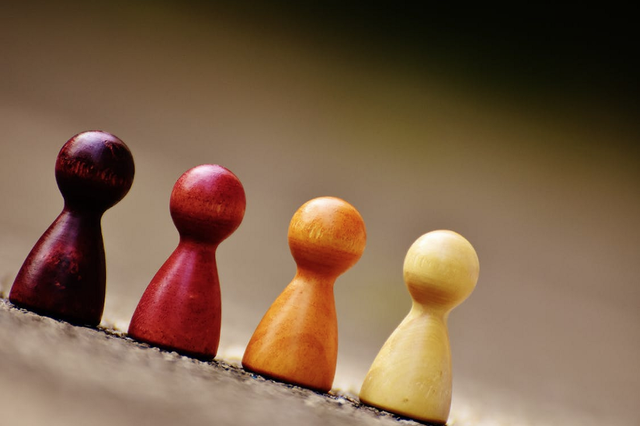How to Build the Future: Creating a Teal Organization With Blockchain and Chatbots
“I never worry about the future.
It comes soon enough.”
Albert Einstein
We can easily recall unfulfilled forecasts about the future in various spheres. Sometimes they are naive like the one about the problems of horse-drawn transport in London and often based on a simple extrapolation of existing phenomena.

But even if futurologists describe the examples of future technology relatively accurately, little attention is paid to the organization of the society itself. Why is this happening? It is easier for us to imagine existing forms of organization simply by equipping them with enhanced tools. Such a discrepancy is especially clearly noticeable in science fiction works: transferring the action to other planets and for hundreds and thousands of years ahead, they preserve stereotypes about workers in workshops, bosses in large offices, secretaries with coffee and miners in helmets.
In the short perspective, the situation with forecasts is somewhat better, but the speed of the changes around us tends to increase. The large companies in various spheres change our way of life and habits, but what about the organizations themselves? What changes should occur in the structure of the company to keep it at least modern or prepared for the future at best? If we are going to formulate a universal answer suitable for any organization, we will spend so much time that will find ourselves in the future.
A good example of the existing organization classification is the work “Discovering Future Organizations” by Frederic Laloux, a former partner of McKinsey. Like any model that represents real processes and devices, the color scale of organizations is presented with a certain degree of conventionality. The author himself agrees with this, pointing out that in the real world organizations successfully combine the features of various approaches to management.

After a historical review and analysis of the organizational paradigm evolution, Laloux distinguished seven stages assigning each with its own color, from infrared to teal. The Infrared and Magenta colors corresponded to the time when humanity first united into tribes, the Red one corresponded to the era of wars and conquests, the Amber color associated with the formation of church and caste organizations, colonies and other hierarchies; the Orange stage corresponded to the gap between the Renaissance and our time, with a materialistic view of the world, the emergence and strengthening of meritocracy with competition; and the Green stage was consistent with the emergence of concepts of stable development and mindset freedom.
The transfer to the next paradigm changed the foundations of human society: the technical and economic base, social orders and political leadership, religious and spiritual orders. It is likely that with the transition to the evolutionary “teal society” we can confidently expect the fundamental foundations of human civilization.
While most of the modern organizations prefer the Orange paradigm, the Green one is more represented in the scientific community, the last, the Teal stage should be sought to build the organizations of the future.
What is so special about the teal organizations of the future? They possess three distinctive features from the organizations of the previous stages and are able to solve problems more effectively.
Self-Management, Blockchain, and Chatbots
The first feature is self-management. The absence of need for a rigid and rigorous hierarchy allows building scalable systems based on the interaction of equal coworkers.
How to struggle with chaos in this case? First of all by organizing the process of internal counseling. In the process of internal counseling, each employee can make any decision, although they should consult with everyone affected by the decision first. If there is not enough information, experts can be brought in to advice in the required field.
A list of topics for discussion is formed in advance, then finalized, and then the decision is collectively accepted in the case of the absence of fundamental objections.

At the same time, you can return to the discussion at any time, at any stage, if there is a need for it or new information has appeared. This makes it impossible to miss an important opinion and, at the same time, does not allow the abuse personal influence. It is important to understand that it is not necessary to reach consensus, full agreement or a majority of votes as this is only the way to an endless series of discussions that are well known, for example, to shareholders at their meetings. The voting mechanism based on the blockchain has already attracted the interest of large stock exchanges, such as Nasdaq.
This approach allows you to get rid of the “pyramidal” approach when top management continuously holds meetings while employees work hard. Getting rid of intermediaries when discussing important processes at the enterprise decreases the need for repeated meetings each time. This can be difficult or time-consuming at the implementation stage, but ultimately employees get an understanding of how the decisions were made and who to contact directly in case of questions.
Thus, to solve similar issues, it will not be necessary to conduct a general meeting as workers from different teams can gather for a meeting. You can also stop wasting time on holding a traditional meeting even in small groups, forming thematic discussions in instant messengers or addressing emerging issues in the corporate chatbot. This will save employees from routine duties, whose benefits are questionable.
Even such an important issue as the wages of employees can be discussed within the group. The total profit of the department can be distributed among employees depending on their responsibilities and their size. Using blockchain for making financial decisions is one of the most niche scenarios for its use, which will allow implementing various automated payment and charging mechanisms in the organization.
How to ensure the implementation control having such an autonomy of employees? At a minimum, a mechanism to fix problems, progress or opportunities is needed. Its implementation can be different: from CRM and manual journaling to a convenient chatbot with a dialog interface. In this case, the use of chatbots working on the basis of existing social networks or corporate messengers wins for flexibility and ease of use for heavyweight CRM or individual error tracking systems.
If the question remains without consideration for a long time, other teams of employees take part in its solution until a ready-made solution is made for each issue.
Such a discussion together with the processes of internal counseling involves everyone, whose advice may be required in resolving the issue. The right people will learn about the problem, dubious ideas will be criticized while the good ones will receive proper support. Traditionally, information about the company’s internal kitchen is considered a secret and not available to ordinary employees.

But not so in teal companies! For example, HolacracyOne developed a program for an internal network called Glassfrog. Any person from outside can find out who is responsible and what is his/her responsibility, read the proceedings of the recent meetings or look at the company’s internal figures, notes from meetings and indicators. One can only imagine how the attractiveness of the companies that don’t resemble a “black box” increases in the eyes of investors.
Is it possible to use a blockchain-based system for such a mechanism? Certainly yes! The composition of work teams and the results of their work, information on decision-making and assigned areas of responsibility, the absence of the ability to manipulate or hide a piece of data form such an open and transparent system that fully corresponds to the concept of a teal organization.
Different teams of employees can compare the results of each others work using the fixation system. In the absence of a hierarchy, self-governing teams literally need all the information available to make the best decisions possible.
The very fact of having “hidden” information with such a structure causes suspicion and can poison the atmosphere of trust in the organization. If we do not consider situations where commercial secrets or technological development are concealed, the presence of “closed” information gives rise to informal hierarchies consisting of trusted and untrusted employees.
Transparency and openness of the results of employees’ work recorded in a decentralized network based on the blockchain is a substitute for the usual control mechanisms. Such a company will be built on the foundation of mutual trust since the results and the process of achieving them will be available to each of the participants.
Using the process of internal counseling and ensuring the transparency of all processes in the company, you can be sure that highly specialized employees will not be left behind when making complex decisions. They will be able to take the necessary measures since the decision-making system itself obliges participants to take important observations into account regardless of their position in the company.
Freedom and responsibility are two sides of the same coin. The solutions based on the blockchain are able to give new breath to the management systems of future organizations providing a high level of transparency and trust between the participants. In addition to the function of tracking and storing information, using the concept of a decentralized autonomous organization (DAO) allows you to set up a series of actions based on smart contract rules. The records of information and financial transactions of DAO and program rules of contracts are stored in a chain of transaction blocks, which allows to scale this structure or to expand the organization if necessary.
Using a chatbot you can also conduct internal counseling by adding information about the outcome of the negotiations to the chain of blocks. This will make it possible to protect employees in case of violation of labor discipline: we live in the real world and understand that various scenarios are possible, including sabotage and untrue information provision. Of course, the creation of a teal organization is built on mutual trust, which greatly increases the complexity of recruitment.
Given the unprecedented (for companies from previous stages) number of data open for analysis, chatbots can use them to improve the quality of internal negotiations. The output of information, diagrams and necessary data directly into the working group chat allows you not to waste time searching and requesting information in the next department. Everyone who once tried to get a manuscript in a large offline library can imagine how much time can be wasted on waiting for information.
In addition, chatbots can be used as an intermediary in resolving conflict situations. In the absence of advancement in solving the problem, you can automatically connect other employees with knowledge in related fields to the conversation. While the disputants are blowing off, the chatbot will offer to resolve the issue with other employees or will put an unresolved issue on the agenda for the following general discussion. Obviously, for this, it will be necessary to equip the bot with an access to the organizations system and run the learning.
Integrity as the Basis for Trust
The second feature is integrity. The personal traits of employees become their advantages. There is no need to follow the standards of the corporation, “wear a mask” or constantly show only narrow-focused professional qualities. Such a company encourages both emotions and intuition in addition to rationalism.

It is difficult to imagine a future company where the dress code is strictly adhered to without proper reason (if we do not talk about the companies where it is necessary because of the duties performed). It is important to convey the procedure of work to the company’s newcomers, as to carry out the adaptation procedure.
You can also use a chatbot at this stage, as it provides a new person with a simpler way to ask questions, and the answers will be provided by a competent staff. The process of adaptation in a self-organizing team is able to disrupt anyone, so let the person get accustomed and give access to all the information. This will allow them to feel trusted and study the work specifics by themselves, even if your new colleague is a professional. For example, in VALVE a paper (and online) versions of the “Freshman’s code” is given out, together with an application to search for employees in the office; in fact, this company is one of the examples of teal teams among game developers.
The understanding of the fact that a slip in the teal company is not an excuse for bullying but only one more topic for discussion and improvement is able to motivate the employee for further growth and feedback.
The situations when an employee “did not know” the necessary information or did not make an important proposal at a convenient moment are minimized. For convenience, it is not necessary to waste the time by letting all participants making offers. You can record all comments, wishes or objections of employees, adjusting the circle of recipients flexibly according to the current situation in the company by connecting the chatbot interface and the company’s blockchain system.
The second paragraph echoes with the “green” organizations in a way, allowing employees to feel as an integral collective, a single “family.” This is the way many modern companies are run, but it is important not only to conduct corporate events but also really feel ourselves part of a single team taking responsibility. Many of the companies claiming their team to be a single family do not really provide their employees with all the information about the company’s operation.
Evolutionary Goal as a Way to the Future
The third feature is the presence of an evolutionary goal. The presence of a strategy or slogan of the company ceases to be an exclusive marketing tool as the employees are trying to understand how to best achieve the overall goal instead of fighting for narrow indicators in the short term.

The head of the future organization retains the responsibility to represent the company in the external world. This is important when customers, suppliers, and supervisors want to communicate only with management.
Many companies use the “Empty chair” technique, but it is easy to reproduce it with more modern methods. The point is to raise the question “Did this meeting serve the purpose of the organization?” at each important meeting and clarifying questions with feedback. Given that the meeting can be held online, chatbots can easily collect this information and then transfer it to the entire team in a convenient form. It is easy to implement such a functionality with the help of existing solutions: BRN.ai chatbots will help to establish both internal and external communication with customers and employees.
Can we assert with confidence that the future belongs exclusively to teal organizations? Intuition tells us that such a powerful tool as blockchain makes this type of organization not only possible; it will necessarily take its position among the organizational paradigms of the future. The most preferred form of ownership for a teal organization is the investors giving credit for its autonomy.
The all-round appearance of such organizations of the future can affect our society much more than industrialization or the development of an accompanying infrastructure.
In the short term, traditional organizations should perhaps be afraid not of jobs shortening caused by artificial intelligence but self-managed teal organizations that can evolve into something bigger, giving people the real goal and ways to achieve it.